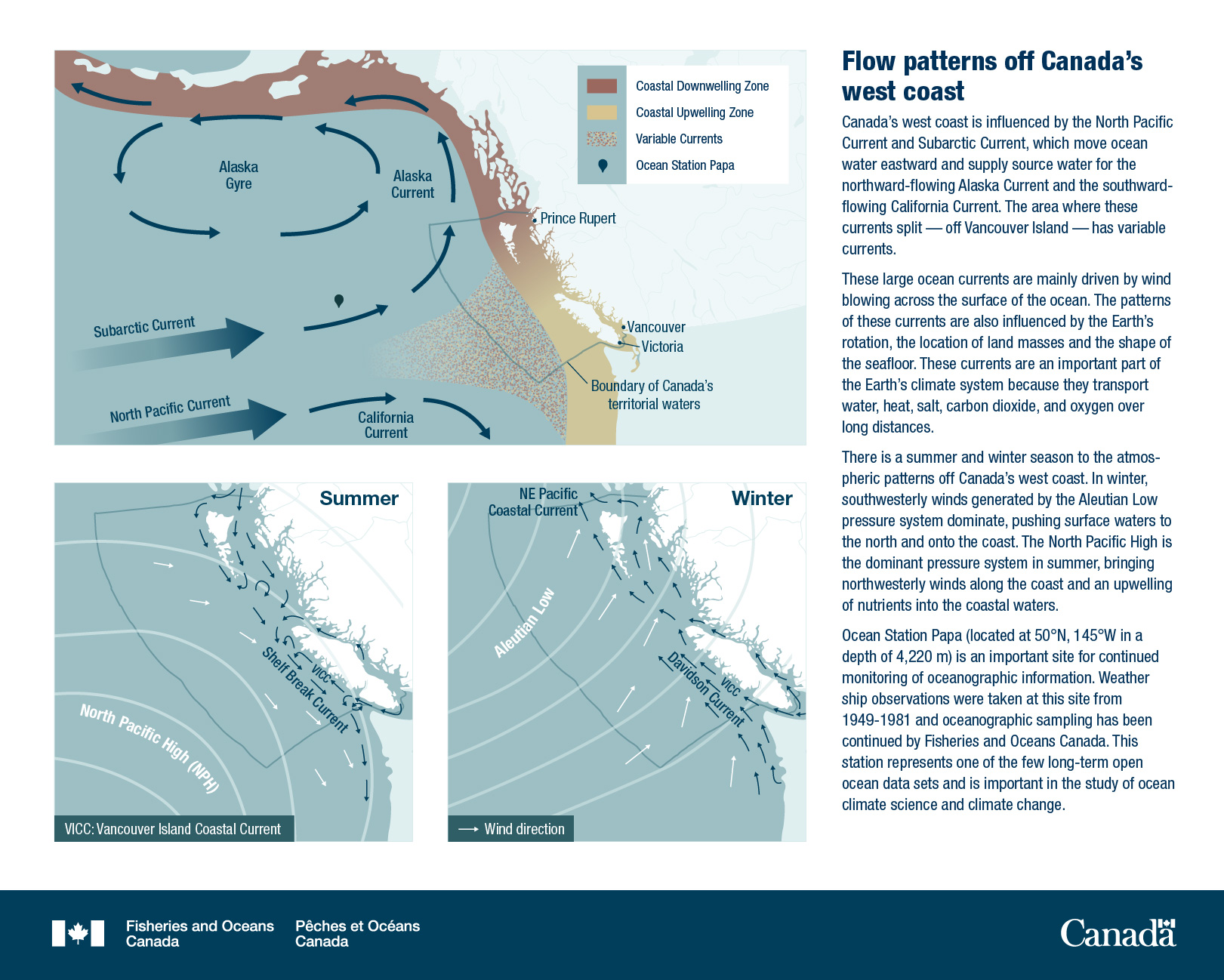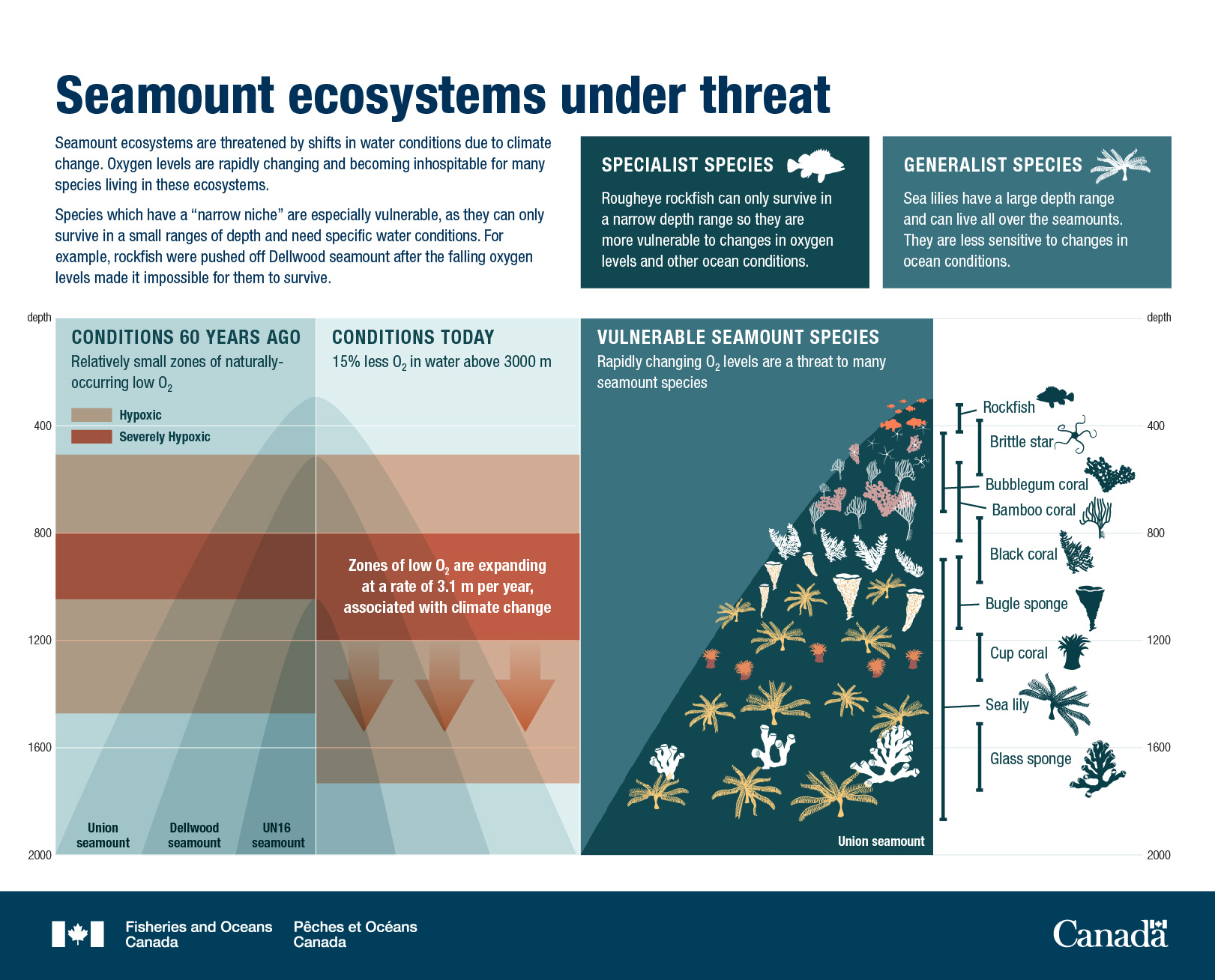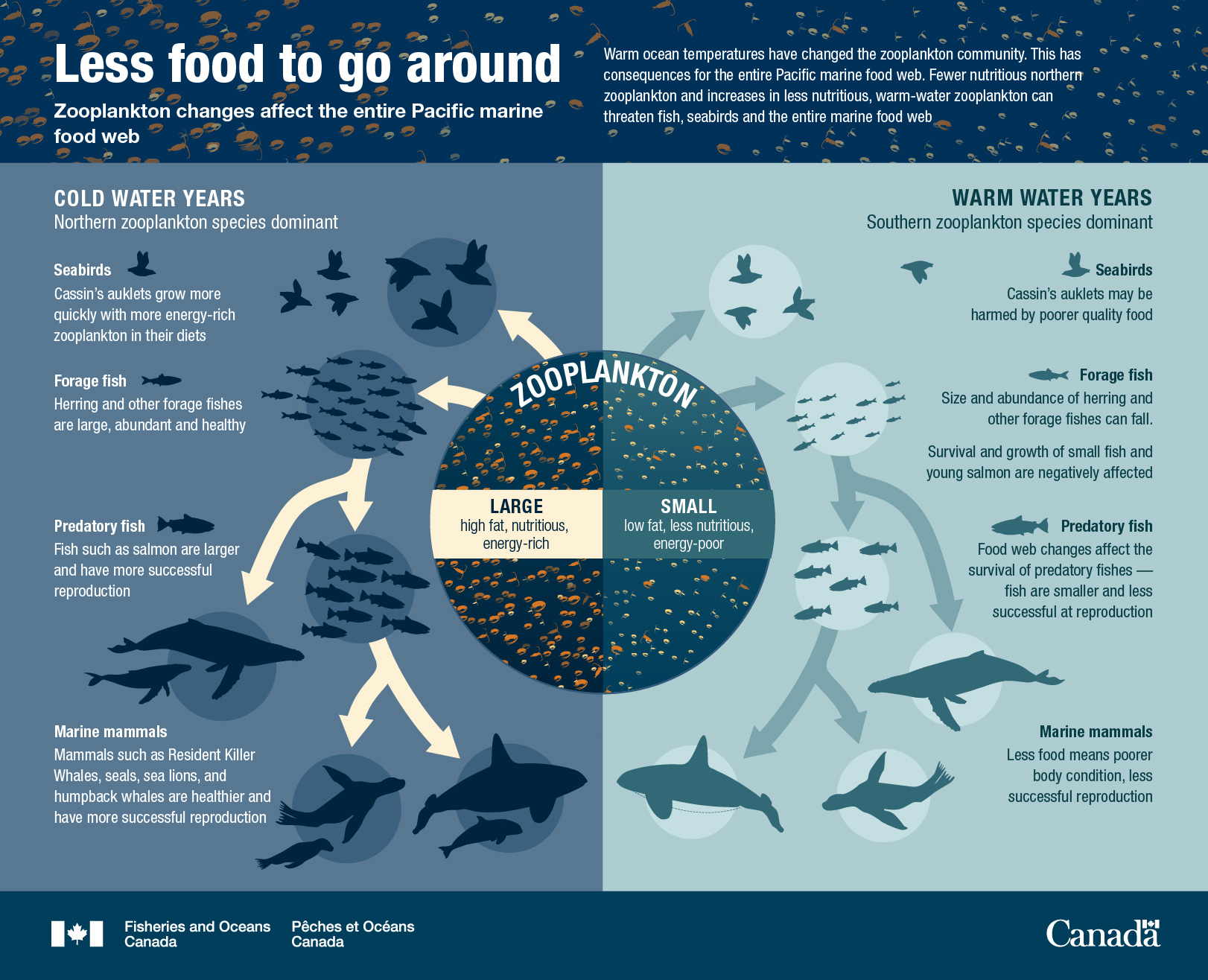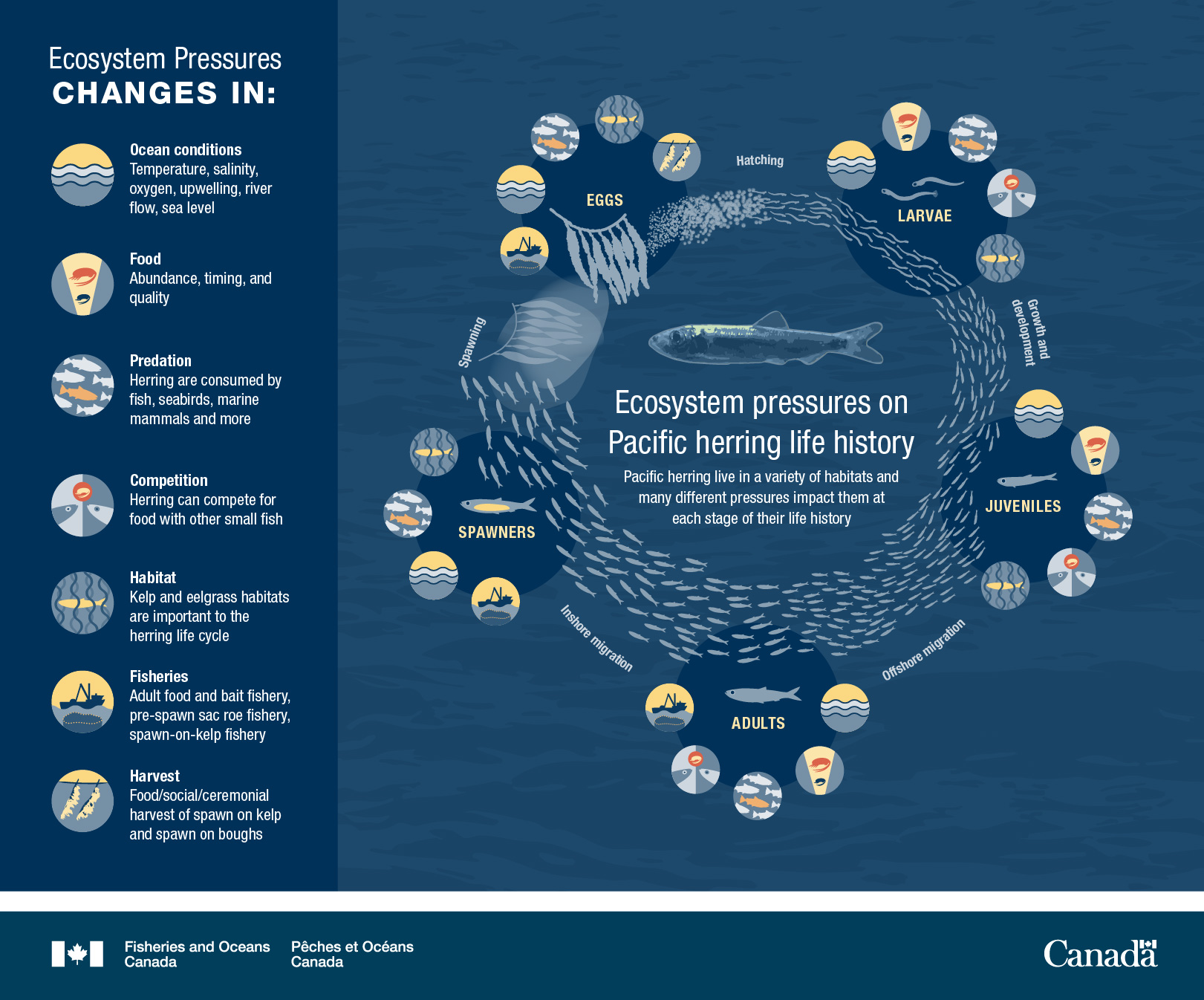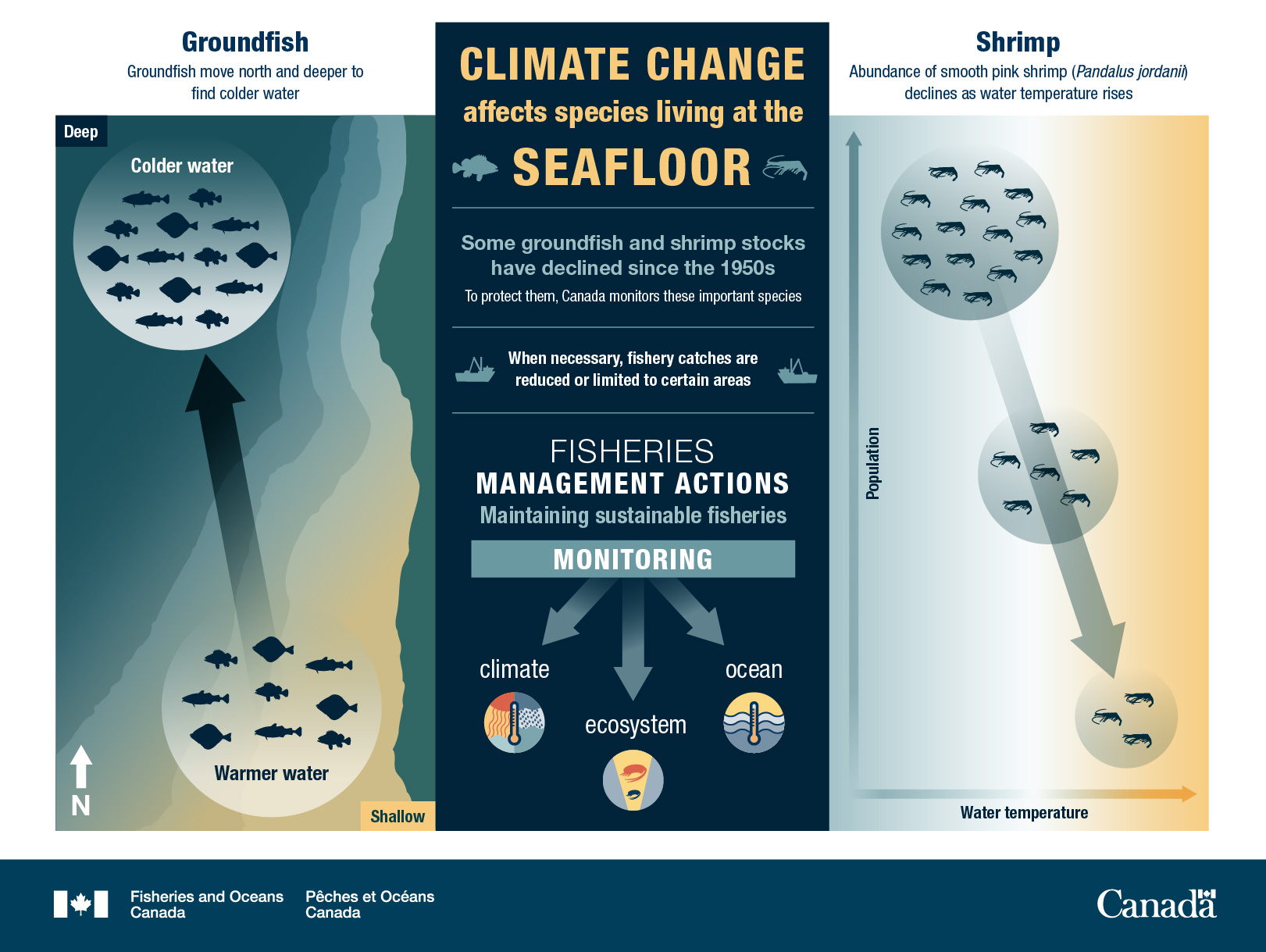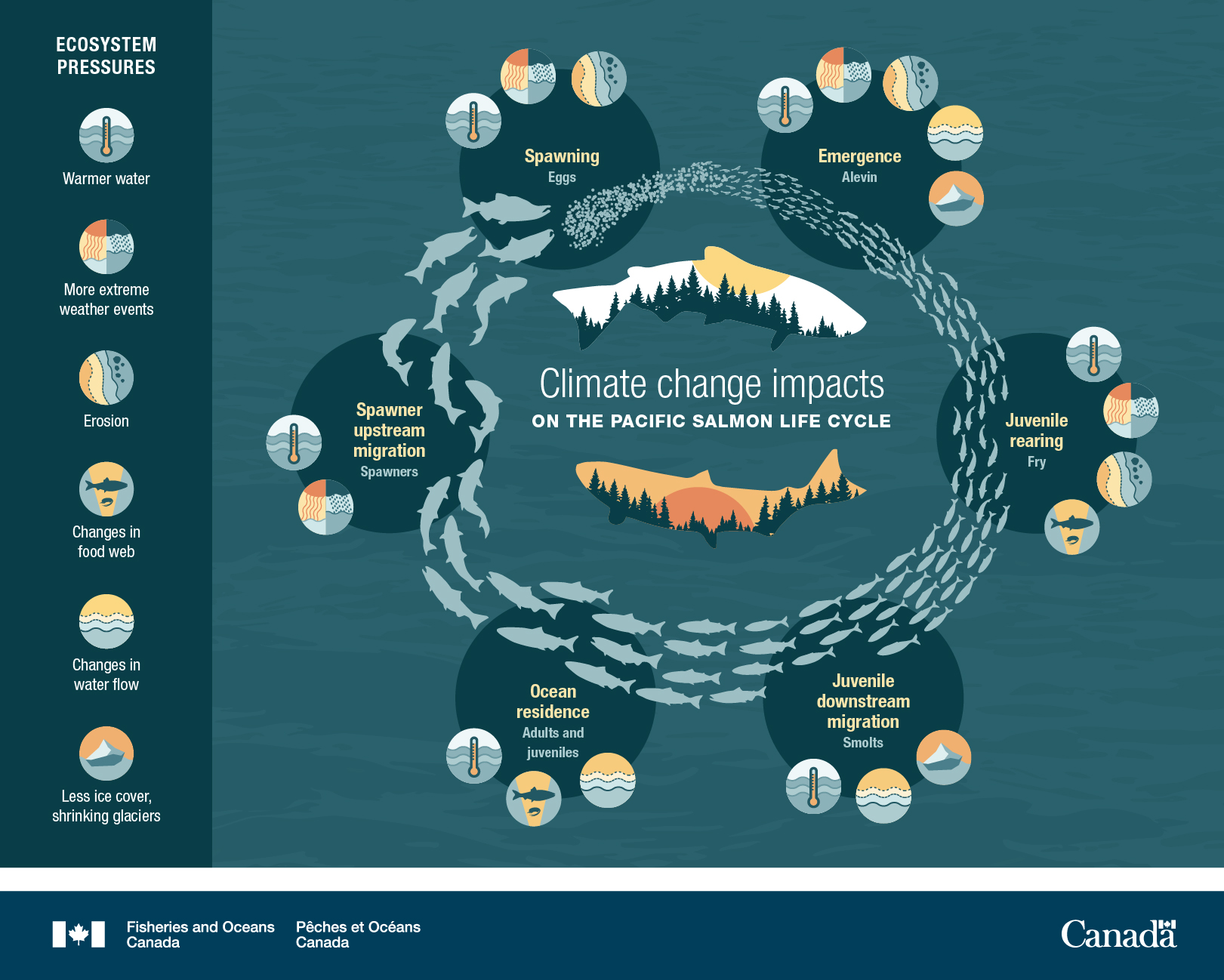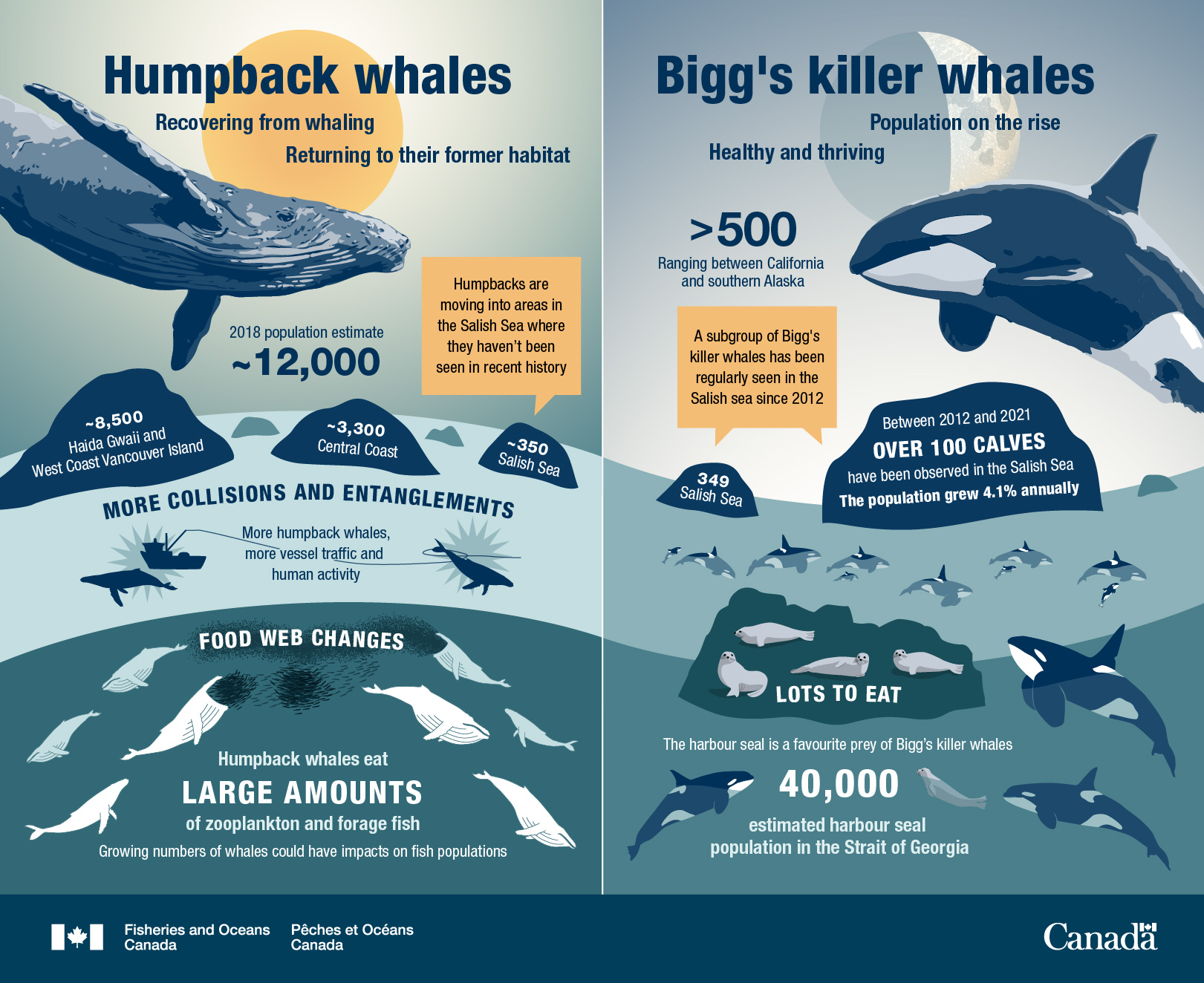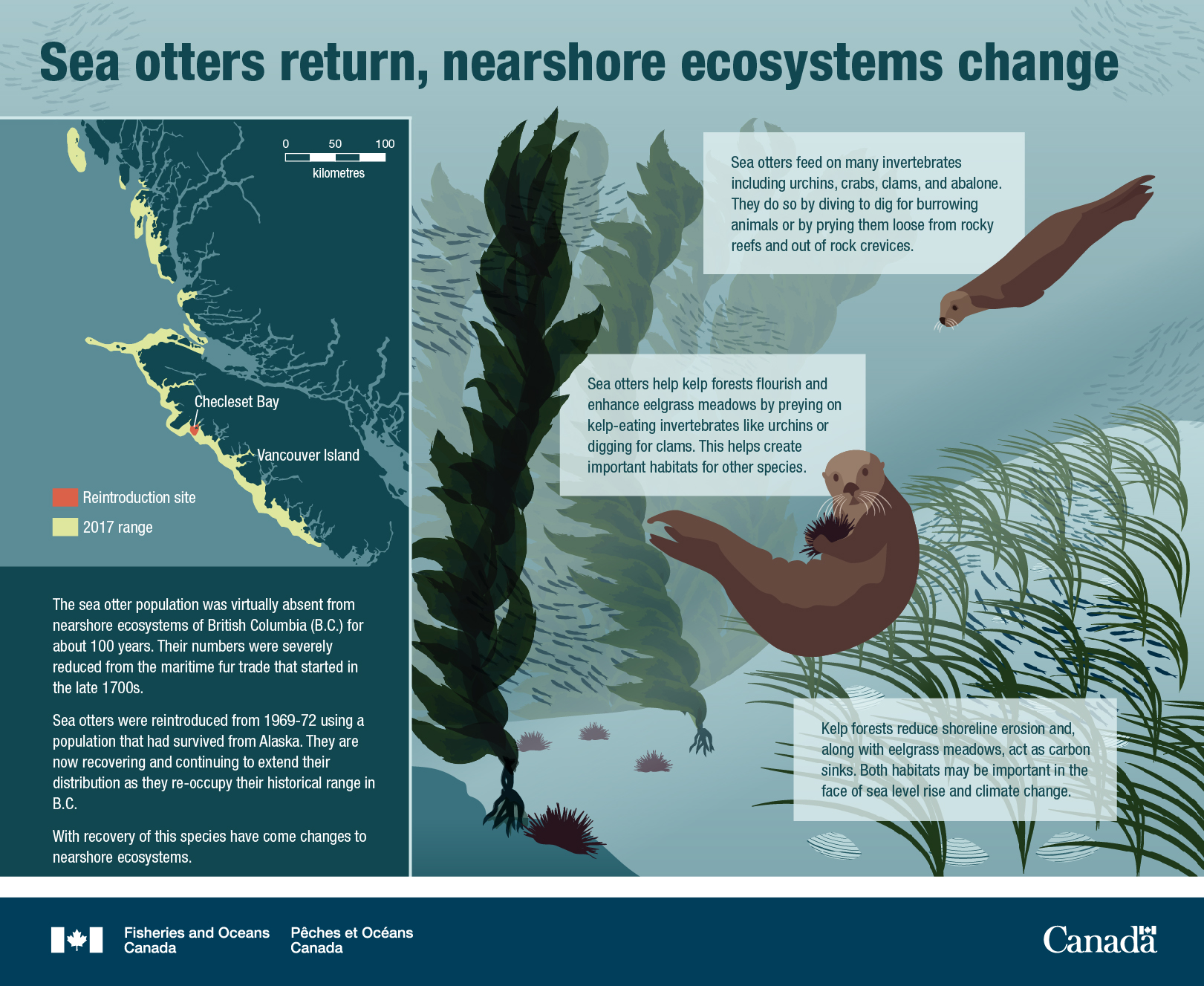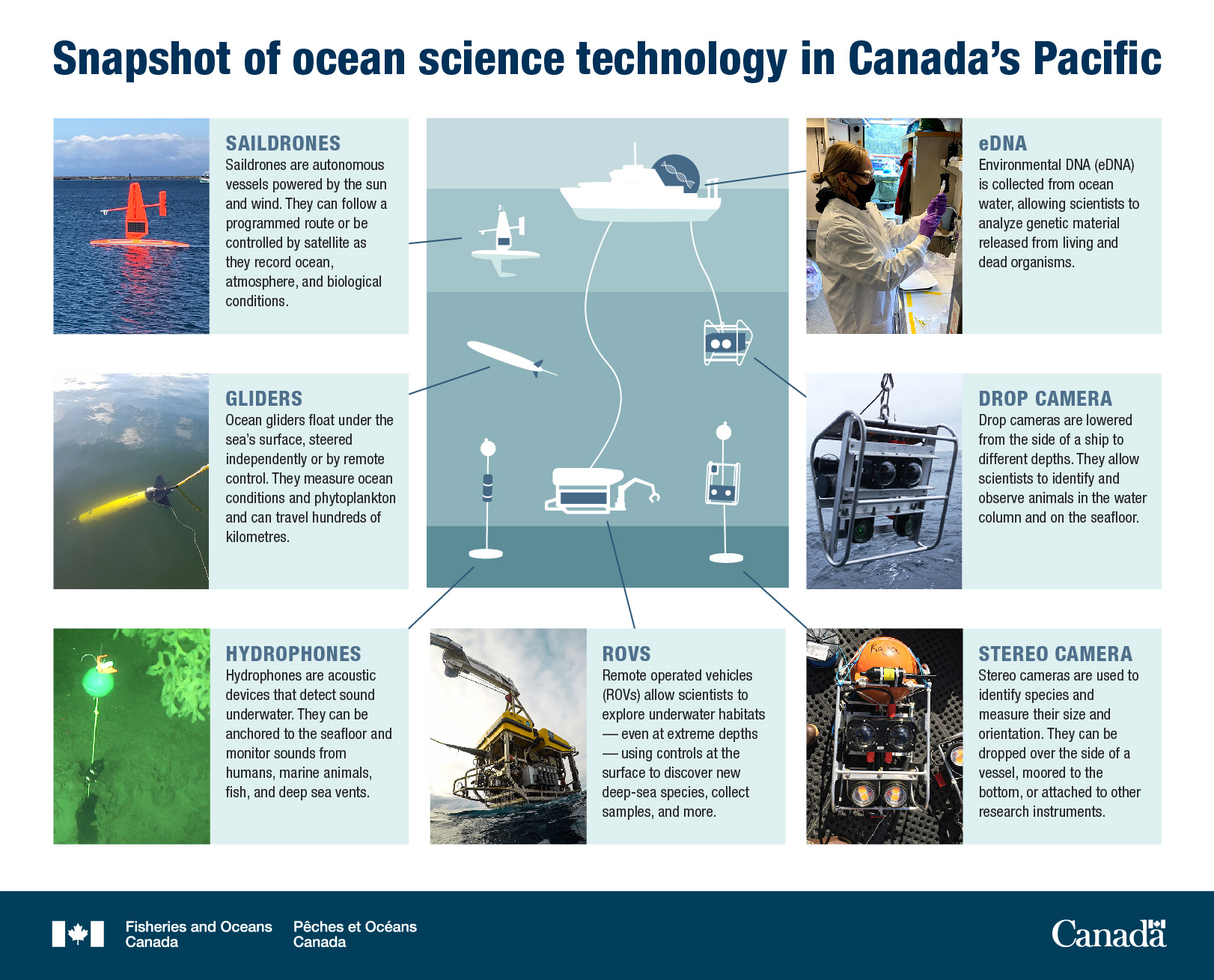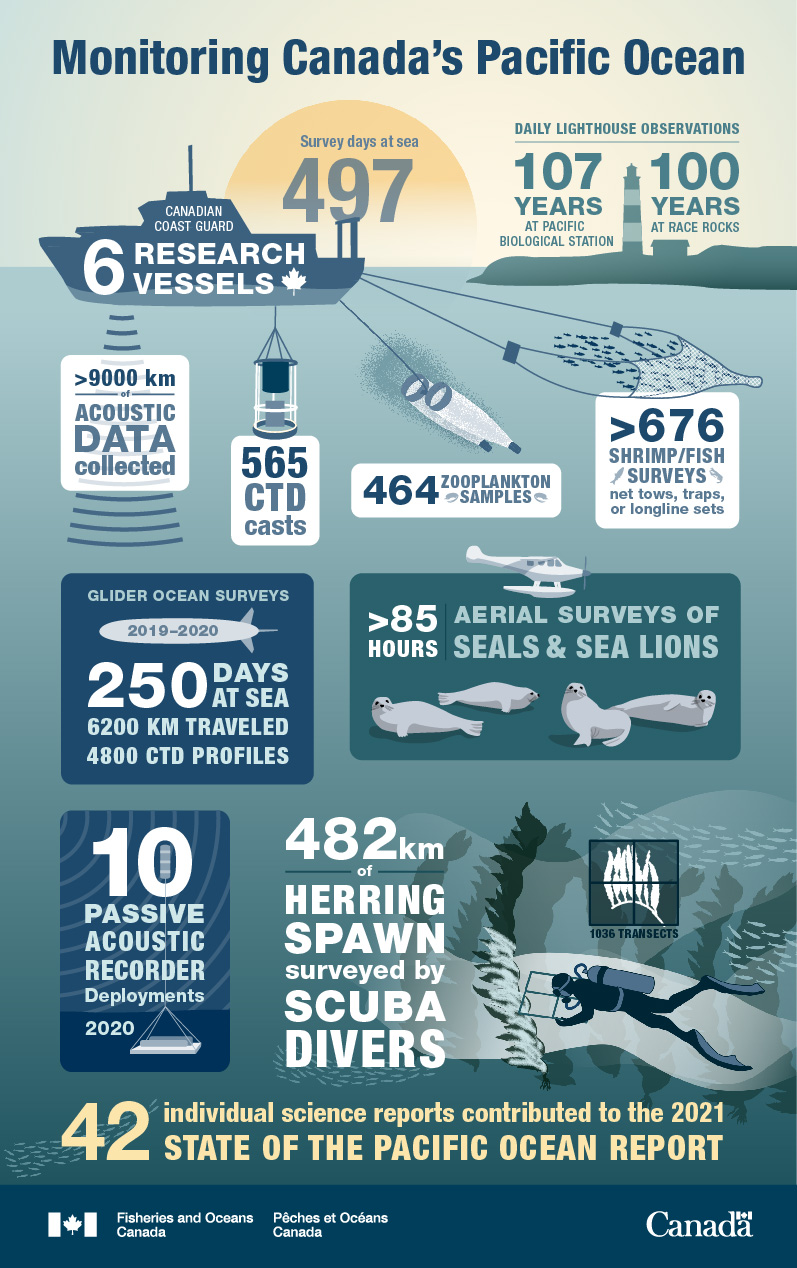Canada’s Oceans Now: Pacific Ecosystems, 2021
On this page
- Foreword
- Introduction
- Canada's Pacific Ocean environment
- Pacific marine ecosystems under stress
- The Pacific Ocean food web
- Pacific marine fish, shellfish and fisheries
- Marine mammals of the Pacific
- Pacific Ocean: Observation and conservation
Foreword
Canada’s Oceans Now: Pacific Ecosystems, 2021 describes the current status and trends in Canada’s Pacific marine ecosystems up to the end of 2020. This report is based on key findings detailed in the Canadian Technical Report of Fisheries and Aquatic Sciences 3377 and 3434, State of the physical, biological and selected fishery resources of Pacific Canadian marine ecosystems in 2019Footnote 2 and 2020Footnote 1. These reports present the results of the most recent year’s monitoring in the context of previous observations and expected future conditions.
Each year, a Canada’s Oceans Now report summarizes the current status and trends of the Pacific, Atlantic, or Arctic Ocean, followed by a national synthesis. The series reflects the Government of Canada commitment to inform its citizens on the current state of Canada’s oceans. The reports highlight and provide examples of the many influences and changes that affect these dynamic ocean systems. This information will be updated in future reports to create an ongoing picture of the status and trends of Canada’s marine ecosystems.
Citations
Boldt, J.L., Javorski, A., and Chandler, P.C. (Eds.). 2021. State of the physical, biological and selected fishery resources of Pacific Canadian marine ecosystems in 2020. Can. Tech. Rep. Fish. Aquat. Sci. 3434: vii + 231 p. https://www.dfo-mpo.gc.ca/oceans/publications/soto-rceo/2020/pac-technical-report-rapport-technique-eng.html
Boldt, J.L., Javorski, A., and Chandler, P.C. (Eds.). 2020. State of the physical, biological and selected fishery resources of Pacific Canadian marine ecosystems in 2019. Can. Tech. Rep. Fish. Aquat. Sci. 3377: x + 288 p. https://www.dfo-mpo.gc.ca/oceans/publications/soto-rceo/2019/pac-technical-report-rapport-technique-eng.html
Introduction
The ocean on Canada’s west coast is often pictured as an endless expanse of blue seas with fog-clouded inlets off rocky shores. Killer whales arc across the sea’s swells alongside breaching humpback whales. 9,000-year-old glass sponge reefs live hundreds of metres below the surface. Pacific salmon start their lives in rivers and streams, mature in the ocean, then return to swim upstream, often hundreds of miles, to lay eggs for a new generation.
The Pacific Ocean is massive, covering almost 30% of the earth’s surface. Canada’s Pacific includes large islands, deep fjords, underwater seamounts, and over 600 km of the continental shelf. It extends from Juan de Fuca Strait (south of Victoria, B.C.) to Dixon Entrance (north of Prince Rupert, B.C.) and 200 nautical miles west from the coast.
Oceans today are facing the impacts of climate change, which is raising temperatures, increasing acidity and lowering oxygen-levels in ocean waters. These multiple pressures impact plants, animals, and other organisms that live in and near the ocean.
A complex web of life ties together the plants, animals and microorganisms that live in Canada’s Pacific. It links them to the geographic and oceanic conditions. When warmer ocean conditions delay the transport of ocean nutrients, plankton growth is affected, which in turn affects the growth of small fishes and shellfish such as shrimp. This affects larger fish, seabirds and mammals that rely on different parts of the marine food web.
First Nations and other communities who live along the Pacific coast rely on the marine plants and animals the Pacific Ocean provides, and are a central part of their cultures. The ocean has also become the basis of large industries such as fishing, tourism, and international shipping.
Canadian scientists and researchers conduct studies of these ocean waters, plants, and animals that add to an international understanding of ocean systems. The scientific reports on which this summary is based on describe many of these elements in detail. Canada’s Oceans Now: Pacific Ecosystems, 2021 gives an overview of the health of Canada’s Pacific. Key findings include:
- The interactions of the ocean and the atmosphere are important factors in the Pacific marine environment.
- Climate change is driving Canada’s Pacific Ocean to warmer, more acidic conditions with lower oxygen levels, while human activities introduce added stressors.
- A food web links all organisms and is affected by the physical conditions in the ocean.
- Changing conditions in the Pacific Ocean have distinct impacts on different fish species.
- Recovering populations of some marine mammal species are affecting the ecosystems they inhabit.
- Ocean observation and conservation activities can help us understand marine conditions and protect Canada’s oceans and its web of life.
Canada’s Pacific Ocean environment
The interactions of the ocean and the atmosphere are important factors in the Pacific marine environment.
What shapes Canada’s Pacific coast?
Canada’s Pacific coast extends over a straight-line distance of less than 1,000 km, however, if all the inlets and headlands are included, the coastline of B.C. is over 25,000 km.
Islands, fjords and rivers
The Coast Mountain Range stretches along the entire western edge of Canada and extends to the coast, creating many inlets, fjords, and islands. Hundreds of rivers bring fresh water from rainfall and glacier melt into the Pacific, with three major inland river watersheds: the Fraser, the Skeena, and the Nass. The Stikine and Columbia Rivers also flow from Western Canada through United States territory into the Pacific.
Two major island groups dominate the coast:
- Vancouver Island, separated from mainland British Columbia by the Salish Sea (includes the Strait of Georgia, Queen Charlotte Strait, Johnstone Strait, Juan de Fuca Strait, and Puget Sound).
- Haida Gwaii is located 100 kilometers west of the northern coast of British Columbia, Canada and is an isolated group of over 200 islands, large and small, totaling approximately 3750 square miles or 1,000,000 hectares.
Continental shelf and slope
The continental shelf forms the key offshore feature of Canada’s Pacific coast. Except for Brooks Peninsula (on northwestern Vancouver Island) and southwestern Haida Gwaii, the depth near the coast remains less than 200 m for 95 km offshore and then drops steeply to depths over 2,500 m. This shelf-break restricts the exchange of water between the coastal ocean and the open ocean, but several undersea canyons allow deep ocean water to move onto the shelf. (See Figure 1)
Offshore, seamounts rise from the deep seafloor to as little as 25 m from the sea surface. They provide unique habitats for a large number of rare species. (See: Hydrothermal vents support unique undersea communities)
Spotlight: Hydrothermal vents support unique undersea communities
Hydrothermal vents release hot, mineral-rich water that helps support a diverse community of organisms. Vented heat and minerals provide energy and raw materials that support the growth of microorganisms, making vent sites richer biologically than the surrounding seafloor. Vent microorganisms form the basis of a unique, localized food chain with high organism densities and growth rates, and unusual animals such as red-plumed giant tubeworms and specialized vent clams.
Researchers believe that over 80% of hydrothermal vent species are rare and live only in these unique sites. More than 500 previously unknown animal species have been identified since the vent ecosystems were discovered in 1977. These species depend on unique conditions such as water depth and currents, temperature, and the specific chemical compounds found at a site. Larvae can drift through the water column to new sites, but hospitable sites are rare.
Hydrothermal vents occur at geologically active sites where the seafloor is spreading. As a result, they face frequent disturbances, even complete destruction in undersea lava flows. Some become clogged with mineral deposits within a few decades. Changing ocean conditions such as warming, acidification, and deoxygenation can affect the sensitive environment at a vent site.
Canada protected the 97-square-kilometre Endeavour Hydrothermal Vents Marine Protected Area in 2003, the first country in the world to protect this type of ecosystem. However, only about 8% of hydrothermal vents world-wide are protected.
What moves Pacific Ocean waters?
The prevailing westerly winds and currents from the North Pacific move ocean water toward the coast where the continental shelf and coastal islands influence its movement. Water movement becomes even more dynamic when it is forced into inland seas and mixes with the outflow of fresh water from the major river systems along the Pacific coast.
Atmospheric influences
In Canada’s latitudes, the prevailing westerly winds over the northeast Pacific are a key influence on marine conditions along Canada’s west coast.
Atmospheric conditions affect ocean currents, temperatures, and upwelling – the movement of cold, nutrient-rich bottom layers of water to shallower depths along the continental edge.
Two dominant atmospheric systems form the main seasonal weather patterns in the northeast Pacific Ocean (See Figure 2):
- In winter, the Aleutian Low Pressure system centred in the Gulf of Alaska rotates counter-clockwise and directs ocean storms toward the coast. The atmosphere absorbs moisture as the storms approach the coast from the southwest, then drops much of it as precipitation, making Canada’s west coast the wettest region in Canada.
- In summer, the North Pacific High system centred west of California rotates clockwise. These conditions typically reduce heat loss from the ocean, causing weaker winds and warmer surface water. These warmer and less stormy conditions generally produce relatively dry summers on the coast.
The interaction of high and low air pressure areas over the North Pacific can create moving streams of heat and moisture, known as “atmospheric rivers.” One such stream, commonly known as the “Pineapple Express”, brings moist air from the Hawaiian region to the Pacific Coast, causing periods of heavy winter precipitation. In other situations, pressure ridges can stall the atmospheric flow, resulting in conditions that lead to marine heatwaves such as the “Blob” in 2014-2016.
Ocean conditions in the tropical Pacific also influence the weather in British Columbia and western provinces. On occasion—approximately every two to seven years—persistent climatic wind patterns known as El Niño or La Niña modify the dominant pattern.
- In El Niño years, Pacific storm tracks move farther south than normal, causing warmer temperatures and drier conditions in western, northwestern, and central Canada.
- During La Niña years, the opposite generally occurs: storm tracks move farther north and closer to the coast than normal. This can bring more stormy, westerly winds and colder than normal temperatures into western Canada.
Ocean currents
Several natural elements work together to generate ocean currents, including tides, winds, atmospheric pressure gradients, heat exchange with the atmosphere, and changes in water density. Closer to the coast, the interaction with land and river discharges also affects the strength and direction of the currents.
Ocean flows
The water circulation in Canada’s Pacific waters is connected to global ocean flows. Cold deep ocean water flows northward from the Antarctic into the Pacific. It warms and rises to the surface as it travels through equatorial regions. Mixing with water from the Bering Sea, the Subarctic Current moves eastwards toward North America. In the offshore region west of Vancouver Island, the current divides to flow south down the west coast of North America as the California Current or to turn north to form the Alaska Current. (See Figure 2)
Seasonal currents and upwelling
Seasonal atmospheric influences modify these global currents to form regional patterns. The summer currents off Vancouver Island, driven by winds from the northwest, move southwards. The rotation of the Earth causes upper layers of the ocean to flow offshore. An upwelling return flow of deeper water rises towards the coast. During this season, nutrient-rich water rises into the coastal zone and fertilizes surface waters, supporting an abundance of phytoplankton and growth throughout the food web. During the winter or downwelling season, coastal currents flow northward toward Haida Gwaii and Alaska.
The earlier that the transition from winter to summer upwelling occurs and the stronger the upwelling winds, the more productive coastal waters tend to be. In years such as 2005, when the spring transition was relatively late, marine coastal productivity was generally average to below-average for organisms ranging from plankton to fish to birds. In recent years, there has been no clear trend in the timing and magnitude of winds favourable to upwelling.
A relatively narrow current, the Vancouver Island Coastal Current (VICC), flows northwards along the west coast of Vancouver Island. (See Figure 2) This current is driven by the joint effects of earth’s rotation and the amount of fresh water entering the coastal regions through precipitation, river discharge (notably the Fraser River), snowmelt, or glacier runoff. Over 100 years of flow data from the Fraser River show that annual discharges are increasing. Seven of the ten most recent years had above normal discharges.
Further north, in Queen Charlotte Sound and Hecate Strait, the flow of fresh water from river runoff supplies the source waters for Haida eddies. (See spotlight – Haida Eddies.)
Spotlight: Haida eddies
Winter conditions off the south coast of Haida Gwaii can form eddies which are rotating masses of relatively warm, nutrient-rich coastal water up to 250 km in diameter. These eddies can persist as much as two years and drift 1,000 km offshore, transporting heat and nutrients to offshore regions. The clockwise rotation of the eddy pushes nutrients down to plankton in deep, low-light areas. Here, they support two to three times more productivity than would otherwise occur. The increased production supports growth at all levels of the food chain.
The eddies frequently drift over offshore seamounts, in regions such as the SG̲áan K̲ínghlas–Bowie Seamount Marine Protected Area, an underwater volcanic mountain with a uniquely productive marine ecosystem. The abundant nutrition triggers a cascade of effects on living organisms, allowing them to survive at deeper depths than is possible at other deep-sea environments.
Ocean warming
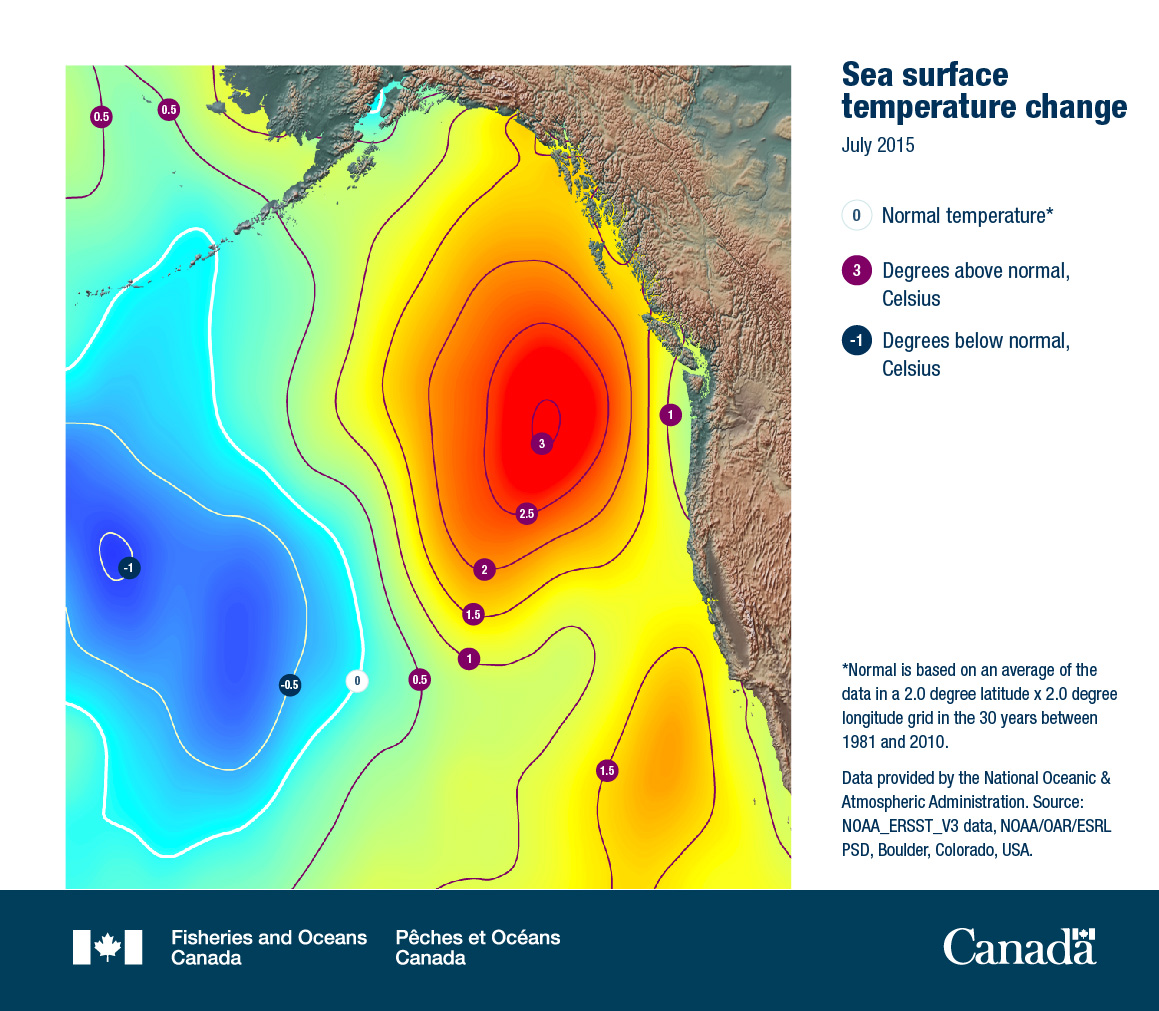
Figure 3: Map showing the area of ocean where sea surface temperatures were significantly higher than normal.
Canada’s Pacific Ocean waters show a long-term trend of ocean warming. Daily sea surface temperatures along the coast of British Columbia over the past 80 years show coastal waters have warmed about 0.7°C. While this increase in temperature may seem small, the persistent change can have a significant effect on the ocean ecosystem as warmer water is associated with lower concentrations of nutrients and dissolved oxygen. Warm conditions can stress species that depend on colder water, such as salmon, and can allow toxic algae to thrive, with effects throughout the food chain.
In addition to a warming trend, extreme warming events, or marine heatwaves, also occur (See Figure 3). Like heatwaves in the atmosphere, a marine heatwave is a persistent period of warmer-than-normal temperatures in the ocean. The number of marine heat waves in the northeast Pacific has increased over recent years. Marine heat waves were recorded in 2014-2016, 2018, and 2020 and are predicted to occur more frequently in the future.
Spotlight: The Blob
The marine heatwave that occurred in the northeast Pacific Ocean during 2014-16, widely known as “the Blob,” was an extreme heat event. Peak surface temperatures up to 3°C warmer than normal persisted for almost two years. The Blob was greater than any previous records in magnitude, geographic scope and duration. It affected the ecosystem from microorganisms to top predators. The Blob was caused by an atmospheric stall, an unusual and persistent combination of factors: warmer air temperatures (which warm the ocean’s surface); changes in the patterns of wind speed, direction, and duration (reducing the mixing of ocean layers and the upwelling effect); and a persistent El Niño mass of warmer equatorial water.
Pacific marine ecosystems under stress
Climate change is driving Canada’s Pacific Ocean to warmer, more acidic conditions with lower oxygen levels, while human activities introduce added stressors.
Climate change causes a variety of impacts
Increasing levels of greenhouse gases in the atmosphere are causing global temperatures to increase. Canada’s Pacific Ocean is absorbing some of the heat and carbon dioxide from this global warming. As a result of these atmospheric changes, surface waters are warmer and more acidic, oxygen levels are dropping, and marine heatwaves are becoming more frequent and more extreme.
Researchers are currently working to assess how these trends affect ecosystems in the northeast Pacific. Some of the following sections look at their impact on living organisms.
Rising ocean temperatures
Changing water temperatures can affect the distribution, growth, and life cycles of plants and animals. They also affect the availability and timing of food sources in marine ecosystems. Ocean currents and mixing redistribute the surface heat and carbon dioxide to deeper waters, causing further changes to marine ecosystems that will likely last for decades.
Warmer ocean temperatures and the reduced circulation they cause, combined with increased nutrients from land, allow harmful algal blooms to expand rapidly. Observers have noted prominent harmful algal blooms in the Salish Sea. In coastal waters, some algal blooms cause farmed salmon losses. The rapid decay of algal blooms can increase ammonia levels, deplete oxygen levels, and disrupt plankton growth.
Reduced vertical mixing
Because warm and cool layers do not readily mix, warmer sea surface temperatures increase layering, or stratification, in the water column. The increased layering reduces the renewal of nutrients by limiting movement up or down through the layers. When layering prevents the movement of essential nutrients, it reduces the production and changes the composition of phytoplankton. This has similar impacts on organisms that consume phytoplankton, whether directly or through the food chain.
Falling oxygen concentration
Waters of the North Pacific are naturally low in oxygen compared to other oceans. In the waters off Canada’s west coast, an oxygen-minimum zone (OMZ), where ocean water holds a very low level of oxygen, lies between depths of about 500 m and 2,000 m. The depth range has expanded over the last 60 years with a 15% reduction in oxygen (See Figure 4).
Falling oxygen levels in the water – deoxygenation – can change the balance of marine life. Most fish prefer oxygen-rich waters and may migrate to regions with higher oxygen levels. They may be replaced by species that tolerate low-oxygen (hypoxic) waters, such as microbes, jellyfish, and some squid.
Rougheye Rockfish
The falling oxygen level in the offshore oxygen-minimum zone appears to have completely displaced rougheye rockfish from Dellwood Seamount. It has restricted these rockfish to the very top of Union Seamount.
A period of severe hypoxia, unusually low levels of oxygen in the water, occurred in the Saanich Inlet, in the southern Salish Sea, from 2015 to 2017 which led to the absence of spot prawn and other commercial shrimp species.. In the same period, the abundance of other animals that live on the seafloor, such as sea whips, also decreased, and new-found species, such as the striped nudibranch and the white sea cucumber, thrived. Mobile animals and animals with shorter life spans started to recover by 2019, but less mobile species and species with longer life spans may not recover for several years.
By contrast, while these low oxygen conditions pose a threat to rockfish, spot prawns and other species, they may be leading to greater numbers of jellyfish in the North Pacific.
Increasing ocean acidification
When seawater absorbs more of the increasing carbon dioxide in the atmosphere, these waters become more acidic. Researchers have observed increasing levels of acidity in the North Pacific over the last 25 years.
Increased acidification causes weakness and damage to the shells of shell-forming animals such as mussels and oysters. This impacts the formation of corals and sponges, which provide important habitat for other species. An increase in acidification can also stress bottom-dwellers such as pink shrimp and groundfish, as well as marine organisms in their larval stages, leading to poorer survival. This can harm the productivity of marine organisms, including commercial shellfish and other species.
Species in coastal fjords may be particularly sensitive to these changes. Shellfish farmers in the Salish Sea report harmful effects from ocean acidification, especially on the larval stages of shellfish species.
Increased nutrients promote algal blooms
High levels of nutrients (nitrogen and phosphorus) flowing from the ocean, as well as from agricultural fertilizers, sewage disposal, and urban runoff promote the growth of algae in coastal areas. Large algal blooms can form on the surface of the water, preventing sunlight from reaching deeper waters and resulting in the death and decay of ocean plants. When the algal blooms die, they sink to the seafloor, where they are consumed by microbes that remove more oxygen from the water. Warmer water temperatures make the problem worse by speeding up algal growth and the rate at which microbes feed on plant matter.
On the Pacific coast, large algal blooms are clearly visible in satellite photographs, particularly near the densely populated estuaries of the Fraser River and Cowichan Bay, in Howe Sound north of Vancouver, and in areas on the west coast of Vancouver Island.
Higher water temperature that results from climate change may be increasing the harmful effects of algal blooms. For example, observers noted high levels of domoic acid (a neurotoxin associated with shellfish poisoning in humans and marine mammals) during the Blob, the 2014-2016 marine heatwave. Higher temperatures may also attract animal species usually seen in tropical waters. (See Travelling dolphins arrive in warming waters)
Spotlight: Travelling dolphins arrive in warming waters
Luke Halpin, a Pacific Ocean researcher studying seabirds observed a large group of bottlenose dolphins and false killer whales – another type of dolphin – travelling off the west coast of Vancouver Island (Halpin et al. 2018Footnote 3). Both species normally live in temperate and tropical waters around the world. The sighting is the only one recorded in Canadian Pacific waters for bottlenose dolphins and it is the first in non-coastal waters of British Columbia for false killer whales. The warming waters of the Pacific may see increasing numbers of animals that usually inhabit warmer regions.
Human activities affect communities of species
In addition to the effects of climate change, other human activities also affect species. Recreational fishing and commercial harvesting affect the number and distribution of the species they target, as well as species that depend on the target species. The growing size and number of Pacific ports leads to habitat destruction or displacement. Commercial shipping creates a threat of introducing and spreading invasive species in Pacific habitats.
Shipping is considered the largest single source of new aquatic invasive species. Ships take on ballast water in foreign ports for ship stability and safety at sea. They then discharge it in Canadian waters, along with foreign species ranging from bacteria to larger organisms. Fishing gear can also transport invasive species through the Pacific regions.
Changing ocean conditions also lead to the introduction of invasive species. Carried in by ocean currents or transported by vessels, non-native organisms may thrive in the changed habitats they find. They can cause extinctions of native plants and animals, reduce biodiversity, compete with native organisms for limited resources, and further alter habitats. They can harm natural ocean resources as well as human use of those resources.
The invasive European green crab, for example, is a hardy and aggressive predator. It feeds on shellfish such as clams, mussels, oysters, smaller crabs and other crustaceans, and even small fish. It can out-compete local species. European green crabs are now found along the entire west coast of Vancouver Island from Barkley Sound to Winter Harbour. Observers found them in low numbers in the Central Coast and Salish Sea, and in 2020 they were detected for the first time on Haida Gwaii. Warmer ocean temperatures may allow them to spread further to other areas of the B.C. coast.
The Pacific Ocean food web
A food web links all organisms to each other and is influenced by the physical conditions in the ocean.
Ocean mixing and circulation affect sea life by influencing the nutrients that phytoplankton can use. Phytoplankton form the base of marine food webs and, like land plants, they take up dissolved nutrients in their environment. They use the energy available from sunlight to convert simple nutrients to sugars, fats, and proteins. The dissolved nutrients that fuel phytoplankton growth transfer throughout the food web when zooplankton, fish, seabirds, and mammals feed on them. Human fishers are also one of the predators that rely on the health of this system for their own nutrition and economic wellbeing.
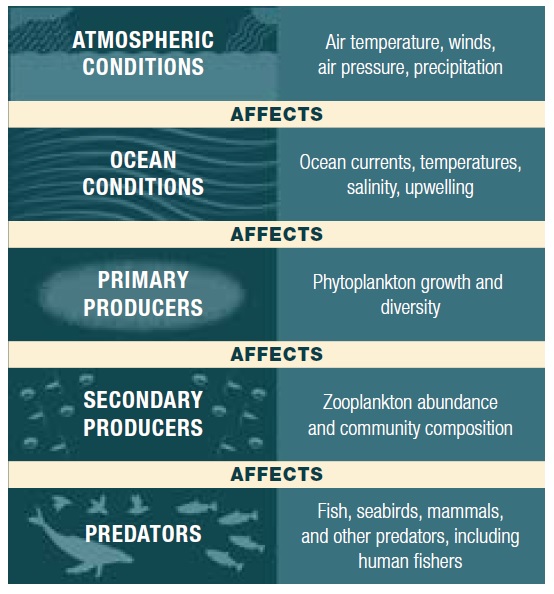
Physical connections between the oceans and a web of life connects the organisms living in and near the sea
Description
Atmospheric conditions, like air temperature, winds, air pressure and precipitation, affects:
Ocean conditions, like ocean currents, temperatures, salinity and upwelling, which in turn affects:
Primary producers, like phytoplankton growth and diversity, which in turn affects:
Secondary producers, like zooplankton abundance and community composition, which in turn affects:
Predators, like fish, seabirds, mammals and other predators, including human fishers.
Pacific Ocean connections
In addition to physical connections between the oceans, a web of life connects the organisms living in and near the sea.
Most Pacific food webs start with phytoplankton (plant-like microscopic marine organisms), which are eaten by zooplankton (small drifting animals). They in turn are eaten by shellfish, jellyfish, fishes, and ultimately marine birds and mammals. Because of these connections, changes to one part of the food web may have implications for the status and health of the rest of the food web.
The livelihoods and well-being of many people in Canada’s coastal communities depend upon marine food webs, too. Changes to marine food webs affect the many people who depend on them. When changes to habitat or environmental conditions affect the Pacific Ocean food web, impacts can be felt all along the web.
Zooplankton communities
Zooplankton are a diverse group of animals, including copepods, krill, jellyfish, and the larval stages of fishes and shellfish. Changes in zooplankton communities affect their predators, such as forage fish and seabirds. Forage fishes, like Pacific herring, eulachon, smelt species, Northern anchovy, and Pacific sand lance, are in turn food for other larger fishes as well as fish-eating seabirds and marine mammals.
Along Canada’s Pacific coast, nutrient-rich deep water rises and mixes into the upper ocean layer. The nutrients feed phytoplankton growth and the rest of the food web. The type and timing of phytoplankton blooms affects the abundance, composition, timing, and distribution of zooplankton species. If the timing of phytoplankton blooms does not match the nutritional needs of zooplankton, the zooplankton growth may be limited. This can affect the amount of food available to their predators, such as forage fishes, seabirds, and whales.
In warmer years, the composition of zooplankton communities shifts. Less nutritious southern copepod species move in on ocean currents, and there are fewer energy-rich northern copepods. The smaller size and lower energy content of southern copepods make them a poorer food for other animals in the food web (See Figure 5). Lower energy content of warm-water zooplankton affects the survival of young salmon. Seabirds, such as Cassin’s auklets, grow more quickly when they have more energy-rich northern copepods in their diets. The poorer quality food in the warming Pacific could harm the world’s largest breeding colony of Cassin’s auklets on Triangle Island, British Columbia
Pacific marine fish, shellfish and fisheries
Changing conditions and human activities in the Pacific Ocean have distinct impacts on different fish and shellfish species.
The Pacific Ocean is home to a variety of fish and shellfish species that are part of a complex ecological community. As both prey and predators, they form key links in the ecosystem. In addition to supporting commercial and recreational fisheries, they support First Nations fisheries and are culturally important to First Nations. They include, for example, Pacific salmon, groundfish, pelagic fish, and shrimp. Some species have viable stocks but some are species at risk.
Pacific herring
Pacific herring are an important species that feed mainly on zooplankton in nutrient-rich waters often associated with offshore upwelling. A key forage fish, Pacific herring are prey for many fish such as Pacific cod, sablefish, and Pacific halibut, as well as animals such as sea lions, seals, and humpback whales. The annual mass spawn of Pacific herring in coastal bays and estuaries provides food for millions of seabirds and thousands of sea mammals.
Pacific herring in British Columbia are managed as five major and two minor stocks. Each year, scientists assess the abundance of Pacific herring and identify strategies to meet objectives for conservation and fisheries management. Each year - in partnership with First Nations, the fishing industry, government, and non-government organizations - scientists assess the abundance of Pacific herring and identify strategies to meet objectives for conservation and fisheries management.
Swimming in large schools from the sea surface to depths of 200 m, Pacific herring off the British Columbia coast can grow to 26 cm and live 14 to 16 years. Every spring, the main migratory stocks of adult herring migrate from overwintering areas to nearshore areas. Here, they spawn along shorelines in intertidal and shallow subtidal zones. Herring generally spawn in similar areas each year, although the specific location can change. Herring deposit their eggs on kelp, eelgrass, and other structures. After spawning, they migrate to their summer feeding areas.
Eggs hatch after a few weeks, although the time can vary with environmental conditions, such as temperature. Larvae remain in nearshore waters for two to three months, feeding in shallow waters. In the summer of their first year, the juveniles form schools in shallow bays, inlets, and channels, then migrate to deep water for the next two to three years.
The total biomass of herring (the total weight of all fish, an indication of the amount of fish present) varies among these areas. In Haida Gwaii waters, biomass is very low compared to the biomass of past years and a rebuilding plan is underway; biomass is relatively high in the Strait of Georgia. Other stocks have recently been steady or increasing compared to prior years. In addition, the average weight of individual herring declined from around 1980 to 2010. However, in recent years, average individual weights have increased in all stocks. This may result from a combination of factors, such as large-scale changes in the environment, food supply and quality, the number of predators, and competition (See Figure 6).
Because Pacific herring depend on zooplankton for food, changes in ocean temperatures that affect the number and type of plankton can affect herring growth.
- Changing temperatures and salinities can cause herring to spawn and hatch before or after the arrival of the plankton, on which they rely.
- Local environmental conditions determine, in part, the specific locations that herring choose to spawn, so environmental changes can cause herring to shift to different spawning grounds.
Groundfish
The term “groundfish” refers to many species of fish, most of which live on or near the seafloor. In Canada’s Pacific, groundfish include Pacific cod, sablefish, halibut, arrowtooth flounder, Pacific hake, lingcod, and many species of rockfish, such as Pacific Ocean perch, boccacio, yelloweye rockfish, and yellowmouth rockfish. Groundfish play an important role in the ecosystem as predators of smaller fish such as Pacific herring. They are also prey for other animals in the ecosystem when they are eggs, larvae, and juveniles. Groundfish are also important to humans; they are used for food, social, and ceremonial purposes by First Nations, and they are fished both commercially and recreationally.
Scientists conduct regular assessments of major fish stocks, including over 70 commercial groundfish stocks. These assessments combine data from fisheries (such as commercial catches) with data from scientific surveys to estimate quantities such as the total weight of all spawning fish (the spawning biomass), growth, and maturity. These data let researchers assess stock status and fishing intensity.
Groundfish species follow a variety of life histories. For example, rockfish species are generally long-lived and slow growing. Some species grow to more than 100 years of age and do not start reproducing until they are 20. Instead of releasing eggs as most other fish do, most rockfish release live larvae, although some release eggs into the water. The eggs and larvae drift with currents and, as they grow, the juveniles settle to relatively shallow waters before moving to deeper waters with adults.
Groundfish stocks, on average, declined from 1950 to around 2000 and have remained relatively stable since then. The change around 2000 followed management changes for trawl fishers. Sustainable fisheries management requires keeping stocks in the healthy zone by avoiding dangers to stocks through fishing or other activities. While average stock status was above the reference point in 2020, some stocks were in the caution zone. Four were in a critical zone where rebuilding is necessary. Cautious management should help rebuild and strengthen stocks over time.
Changing temperatures on the seafloor may be affecting where some fish species live (See Figure 7). Over the past decade, the total biomass of some groundfish species has decreased in already warm areas of the coast that are warming further. Many species appear to be stable or increasing in cooler areas. This may be because competitors or prey species have changed, or because colder temperatures support healthier egg development, allowing more of the young population to survive to join the spawning adult population.
Extremes in ocean conditions may harm some species, while helping others. Bocaccio, for example, a large rockfish species that can live up to 45 years, had declined by more than 95% over the past 50 years. However, in 2016, many young bocaccio survived, perhaps because more oxygen became available at lower depths. The increased abundance of bocaccio could reverse the long-term decline of the species.
Recent losses of spawning habitat, due to changes in ocean conditions, may have prevented some groundfish, such as Pacific cod, from spawning successfully. By contrast, changes in the Strait of Georgia ecosystem, including the timing of plankton growth and the number of pinnipeds, such as harbour seals, may limit the recovery of lingcod following declines due to fishing from the 1930s to the 1980s.
However, the factors most likely influencing trends have been fishing and fish management. Changes in management in the late 1990s and early 2000s reduced overall fishing and since then relatively constant catch quotas have been maintained for many species.
Pacific shrimp
About 85 species of shrimp live off the Pacific coast of Canada. Seven species are fished commercially by trawl and trap fisheries including smooth pink shrimp. Shrimp have an important role in the marine ecosystems of bottom habitats from rock to mud and sand. Shrimp are an important food source for many marine organisms including groundfish, mammals, and large invertebrates.
The smooth pink shrimp lives for about three years. After settling as larvae in the summer, they start off as males and then change their sex in mid-life, becoming females in the third and final year of life. They spawn in the late fall or early winter, and females carry eggs throughout the winter until the eggs hatch in the spring.
In 2019, off the west coast of Vancouver Island, researchers found the total amount of smooth pink shrimp was among the lowest since the records began in 1973, well below the average levels.
Just as changing sea temperature appears to affect the number of groundfish, it also affects some shrimp (See Figure 7). Off the west coast of Vancouver Island, for example, warmer ocean temperatures may be reducing the survival of smooth pink shrimp larvae, which prefer cooler temperatures. Other factors may also change as the temperature rises, such as the number of predators in warmer waters. Both conditions could reduce the number of surviving shrimp.
Pacific salmon
The life cycle of Pacific salmon species—chinook, sockeye, coho, chum, and pink salmon—takes them from spawning grounds in freshwater streams, downstream to coastal estuaries, into the ocean and then back again. There are more than 9,000 salmon populations (species and stream combinations) in B.C. They occupy diverse habitats, and their life history strategies vary greatly. For example, pink salmon migrate to the ocean immediately after emerging from the gravel as fry, while sockeye spend one to two years in their nursery lake before migrating to the ocean as smolts.
Salmon play a key role in the marine and freshwater ecosystems they use throughout their lives. In B.C., they are vitally important to First Nations for food, social, and ceremonial purposes, and they contribute to Canada’s west coast society through recreational and commercial fisheries.
Canada’s salmon catch has fallen in recent decades, and was extremely low in 2019 and 2020. Despite large reductions in the commercial catch, the number of spawning salmon is declining for many species and populations.
Pacific salmon occupy a wide variety of ecosystems and are exposed to many threats, such as fishing, disease, invasive species, and other ecosystem changes. Climate change alters the ecosystems that salmon depend on at every stage of their life cycle. Habitat changes related to climate include marine heatwaves and higher ocean water temperatures; food web changes; changes in glacier melt and timing of peak river flows; warmer freshwater conditions; more extreme rain and drought; and increased erosion (See Figure 8). These can all affect salmon survival. For example:
- Some river temperatures in summer months are becoming too warm for salmon.
- Changes in water temperatures and freshwater flow can cause salmon to migrate before or after the food sources they rely on become available.
- Deforestation, extreme precipitation, increased dry periods, and other changes degrade freshwater salmon habitats.
- Ocean warming causes shifts towards less nutritious zooplankton species in the northeast Pacific, which affects the whole salmon food web and reduces salmon productivity.
These threats are altering the numbers and locations of Canada’s Pacific salmon populations that survive to spawn. Generally, some species are faring better than others, though there are exceptions to these trends.
- Sockeye populations have been declining, particularly at southern latitudes. Northern populations have also declined recently. Returns in 2020 were generally below their 40-year average, continuing these recent trends.
- Chinook are declining throughout the west coast, with some exceptions. A number of southern populations are facing an imminent threat of extinction.
- Coho have been declining at southern latitudes, though recent returns in 2019 and 2020 varied by stock.
- Chum have generally been doing better than chinook, sockeye, and coho in recent decades, though they generally had very poor returns in 2019 and 2020.
- Pink are generally doing better than other species.
Differences between the species and populations can give clues into what factors make them more resilient to future climate change. More research and monitoring on these factors can improve management of salmon in a changing climate.
Marine mammals of the Pacific
Recovering populations of some marine mammal species are affecting the ecosystems they inhabit.
Marine mammals such as whales, sea lions, and sea otters were greatly reduced by historical hunting and whaling. Harvesting restrictions and other management measures have led some species to recover and recolonize their former habitats. As a result of these strong recovery trends, marine mammals are once again becoming important components of their ecosystems. This will likely result in food web changes that can affect ecosystems and coastal communities in various ways. For instance, the populations of the northern resident killer whales, Bigg’s (transient) killer whales, and humpback whales have been increasing. The number of Steller sea lions in B.C. increased in the 1990s and 2000s, and has leveled out at about 40,000 since 2013.
Bigg’s killer whales and harbour seals
Bigg’s killer whales, a population of at least 500 mammal-eating orcas, range from southern Alaska to California, both in coastal waters and offshore (See Figure 9). In recent years, a subset of almost 350 individuals have been spending more time in the inland seas of British Columbia and Washington, and in particular within the Salish Sea. Their numbers appear to have grown at an average annual rate of 4.1% since 2012, with the birth of over 100 calves during the time period. This increase shows a healthy population with relatively low mortality.
Bigg’s killer whales consume mammal prey including harbour seals, Steller sea lions, and harbour and Dall’s porpoises. The increase in Bigg’s sightings coincides with an increase in their main prey, harbour seals that may have attracted the killer whales to the Strait of Georgia. Their growing number is likely slowing the population growth of harbour seals.
Southern Resident Killer Whales
The endangered southern resident killer whale population is at an estimated 73 individuals. Their main food source, Chinook salmon, is declining across the coast and as they face increasing pressure from human activities.
Humpback whales returning to their former habitat
Humpback whales have continued to recover from past exploitation and have reoccupied their former habitat in British Columbia (See Figure 9). A coast-wide ship survey in 2018 studied their summer abundance, estimated at about 12,500. This includes about 8,500 on the continental shelf off the west coast of Vancouver Island and Haida Gwaii, and 3,300 along the Central Coast.
Earlier surveys did not detect any humpback whales in the Salish Sea, but the 2018 survey estimated their number at 350 in that region. These observations show that they are moving into areas from which they were still largely absent in the early 2000s.
Humpback whales consume large amounts of food, including zooplankton and forage fish, so their growing number could have impacts on fish populations.
As the number of humpback whales in Canada’s Pacific increases, and vessel traffic also increases, the number of ship strikes and other incidents, such as entanglement in fishing gear, will likely increase as well. Incident reports for 2019/20 listed 714 incidents involving marine mammals in the Pacific, including 333 for species listed in the Species at Risk Act such as north Pacific humpback whales.
Sea otters rebalance kelp forest grazing
Sea otters have increased in number after receiving protected status. They had been hunted to near extinction, but were reintroduced to British Columbia in the early 1970s (See Figure 10). They benefitted from the abundant prey populations of sea urchins, which had grown rapidly in their absence.
The number of sea otters in British Columbia was estimated at 8,100 in 2017. The annual rate of increase across B.C. was 5.2% per year for the period 2013 to 2017. However, growth rates are lower in areas that sea otters have occupied for longer periods of time, where they have consumed large numbers of their sea urchin prey. By preying on sea urchins, sea otters have reduced the grazing of kelp, which has allowed the kelp forests to flourish and spread. They have also been shown to enhance eelgrass meadows when digging for clams. In this way, sea otters have played a clear role in structuring and changing nearshore ecosystems and leading to increases in the density and diversity of marine fauna.
Pacific Ocean: Observation and conservation
Ocean observation and conservation activities can help understand marine conditions and protect Canada’s oceans and its web of life.
In Canada’s Pacific Ocean, many organizations monitor marine ecosystems, including government agencies, First Nations, universities, non-governmental organizations, and citizen scientists. This broad coalition influences how and why marine scientists carry out their work. Technical advances have improved the ways they acquire, analyze, and share ocean data. With these technical developments, including the use of satellites, remote sensing, and innovative analyses, they can develop new monitoring programs and add to programs that they have used for decades.
Ocean scientists want to know about the physical, chemical, and biological processes in the Pacific. They also need to understand how climate change is affecting the ocean and the role of humans in that change. Canada can then apply this understanding to support healthy ecosystems, sustainable fisheries, and effective marine protected areas.
Advances in ocean technology
Scientists and engineers have developed new sensing tools and methods, and adapted others, to better monitor conditions in the ocean. These advances allow researchers to gain more detailed, more broadly based data than they could in the past.
Some novel ocean survey technologies used in the Pacific include (Figure 11):
- Gliders. Ocean gliders can travel hundreds of kilometres under the sea’s surface. They carry sensors to measure conditions such as temperature, salinity, and dissolved oxygen, as well as tools to detect phytoplankton. Gliders can travel independently or by remote control for several months. In the Pacific, researchers also use gliders to survey seamounts and the surrounding waters, which are difficult to study closely otherwise.
- Saildrones. Powered by the sun and the wind, saildrones are autonomous vessels, generally less than 30 m long. They can sail up to 30,000 km and for up to 12 months. Researchers can program saildrones to follow a repeatable survey route or control them by satellite. The onboard sensors record oceanographic, atmospheric, and biological conditions, and they relay data via satellite to a base station. They also can collect acoustic data, which can help estimate how much fish and zooplankton are present. A recent joint Canada-US fisheries survey used a fleet of five saildrones to gather data on hake, sardine, and anchovy stocks.
- Acoustics. Researchers use sound in the water to measure ocean currents, identify vegetation like kelp beds, and estimate the numbers of animals underwater. They can measure the size and distribution of gas bubbles that may mark the location of deep-sea vents. Acoustic studies show what the underwater soundscape is like and how it affects the organisms present. Acoustic listening devices anchored to the seafloor are key to monitoring the population of southern resident killer whales and their prey around Vancouver Island.
- Optics. Scientists have adapted techniques of optical analysis to use on existing monitoring platforms such as remotely operated vehicles (ROVs), drop cameras, and moored instruments that gather data from the surface to the sea floor. Optical data provide not only stunning underwater images but also the bio-geochemical and physical characteristics of material and organisms. For example, with stereo camera images, researchers can estimate the size of animals.
- Environmental DNA (eDNA). By analysing the genetic material released into the water from living and dead organisms, scientists can identify what organisms are in the area and estimate the population size. Analysis of eDNA helps them identify risks to farmed and wild fish by monitoring diseases and water-borne viruses, and it lets them detect aquatic invasive species at an early stage.
Exploring cumulative effects
Natural processes and human activities are connected with a number of environmental stressors. Examples include physical, chemical and biological changes in the environment. An individual event may have no significant effects on nearby marine species, populations or ecosystems, but when multiple stressors are combined over space or time their effects on the environment may add up – these layered stressors are known as cumulative effects.
In the Pacific, for example, salmon species may be affected by several stressors through their life that impact populations. Environmental changes, such as warming water, can lower their survival rate in early life stages; commercial development of estuaries can alter the habitat they use to enter ocean waters; and fisheries can reduce their number as adults. A salmon population that could normally survive one or two of these stressors may become threatened over time through the cumulative effects of all three stressors together. Even stationary habitats or species in the Pacific may be cumulatively challenged over time as they encounter multiple disruptions to their normal physical or chemical environments.
How parts of the marine ecosystem may respond to multiple stressors is difficult to track or predict. So understanding cumulative effects in these ecosystems needs extensive scientific research. Collecting baseline ecological information, such as water temperature, population numbers or habitat health, and monitoring that information over time can help researchers better predict and assess how cumulative effects impact the environment.
Vancouver and Prince Rupert ecosystems
Starting in 2017, Fisheries and Oceans Canada has supported projects from local First Nations to describe the current state of the ecosystem in the Ports of Vancouver and Prince Rupert. This Indigenous-led data collection spans all aspects of the ecosystem, including physical and chemical water properties, contaminant levels, habitat characterization, and the abundance and distribution of species. These projects reflected community values through a list of target ecosystem components that was established by First Nations scientists and Fisheries and Oceans Canada.
Salish Sea ecosystems
Fisheries and Oceans Canada is working to help assess, understand, and manage cumulative effects in the Salish Sea ecosystem. As part of the project, Canada is investing in the capacity of 33 First Nations along the Salish Sea to monitor and evaluate the impact of human activities on their local ecosystems. This includes supporting Nations’ activities to gather data, incorporate Indigenous knowledge, and establish a cumulative effects baseline of selected valued ecosystem components. These Indigenous-led activities will add to the overall available data to support co-management from the perspective of their Nations’ values.
Ocean protection and conservation
Scott Islands marine National Wildlife Area
The marine area around the five Scott Islands off the northwestern tip of Vancouver Island is an ecologically and biologically significant area. It provides important habitat for several marine mammal species at risk. The area attracts 5 to 10 million migratory birds each year, including some, such as the sooty shearwater, that are at risk globally. The Scott Islands are a critical breeding and nesting habitat for 40% of British Columbia’s seabirds. In 2018, Canada established this region as a National Wildlife Area (NWA).
A unique collaboration was created for the Scott Islands NWA, including three federal government departments; the Province of British Columbia; the Tlatlasikwala and Quatsino First Nations; and stakeholders including industry and environmental organizations. Regulations prohibit certain activities that could endanger the wildlife and wildlife habitat, while allowing others, such as fishing.
Critical breeding and nesting habitat
The Scott Islands are a critical breeding and nesting habitat for:
- 50% of all Cassin’s auklets
- 7% of all rhinoceros auklets
- 90% of Canada’s tufted puffins
- 95% of Pacific Canada’s common murres
Monitoring of SG̲áan K̲ínghlas-Bowie Seamount (SK̲-B) Marine Protected Area with the Haida Nation
For over a decade, the Haida Nation and the Government of Canada have cooperatively managed SG̲áan K̲ínghlas-Bowie Seamount, through the designation of the SG̲áan K̲ínghlas-Bowie Seamount Marine Protected Area, the establishment of a management board, and joint research expeditions and projects.
SG̲áan K̲ínghlas-Bowie Seamount, the shallowest seamount in the North Pacific, rises from 3,000 m to within 24 m of the ocean’s surface. It is located 180 km offshore of Xaadáa Gwáay Haida Gwaii. The seamount is the home of a Supernatural Being known as SG̲áan K̲ínghlas, which in Xaad kíl means “supernatural being looking outwards”.
In 2018, the Northeast Pacific Seamounts Expedition combined research ships and submersible vehicles to explore three seamounts: SG̲áan K̲ínghlas-Bowie, Dellwood, and Explorer. The research team livestreamed the events to enable public participation and youth engagement.
Studying the Central Coast with Heiltsuk and Kitasoo/Xai’Xais peoples
Recent expeditions to explore the deep fjords of the Central Coast of British Columbia have been led by the Heiltsuk and Kitasoo/Xai’Xais First Nations, Central Coast Indigenous Resource Alliance, and Fisheries and Oceans Canada.
Fjord habitats are home to complex rocky reefs with a high diversity of vulnerable rockfish and habitat-forming cold-water corals and sponges. Marine life flourishes in these unique coastal habitats, yet western science in these areas is minimal. Weaving traditional knowledge and western science is essential to a complete understanding of these ecosystems. Partnerships such as the fjord expeditions play a key role in determining what kind of protection is needed and where.
Conclusion
Hundreds of days at sea surveying Canada’s west coast contributed to the collection of data used for monitoring these Pacific ecosystems (See Figure 12). From daily lighthouse observations to aerial and dive surveys, over time, these annual monitoring efforts add to our understanding and the status and trend information we know about Canada’s Pacific marine environment. The past year has been unique due to the COVID-19 pandemic which impacted research and monitoring efforts in various ways (See COVID-19).
In Canada’s Pacific, climate change is a dominant pressure acting on marine ecosystems, causing warmer temperatures, less oxygen, and acidified waters. These pressures impact marine food webs, fish and marine mammals alike, with added stressors from human activities. The ocean observation, research and monitoring work along with conservation activities can help us better understand marine ecosystems and protect Canada’s Pacific Ocean as we continue to learn more.
Spotlight: COVID-19
The COVID-19 pandemic affected marine science research in the Pacific in a number of ways. Monitoring programs based on vessels were either cancelled or modified to reduce the number of scientists onboard. Scheduled visits to recover data from instruments in remote areas were delayed. Collaborative work with First Nations in their territories was postponed. These changes reduced the opportunities to observe the marine environment and resulted in gaps in data records.
- Date modified:

